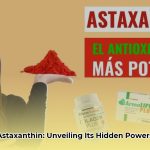Heard of astaxanthin? This vibrant red compound, found in salmon and algae, is generating significant interest for its potential health benefits. This comprehensive guide explores what astaxanthin is, the science behind its potential advantages, and practical advice on how to use it effectively.
Understanding Astaxanthin: What is it and Why the Buzz?
Astaxanthin is a natural pigment belonging to a class of compounds called carotenoids, which give certain seafood (like salmon, krill, and shrimp) their characteristic pink-red color. It’s recognized as a potent antioxidant, and that’s where much of the excitement lies. Antioxidants protect your cells from damage caused by unstable molecules known as free radicals. These free radicals are a natural byproduct of our metabolism, but factors like pollution, smoking, and sun exposure can increase their production. An imbalance—too many free radicals and not enough antioxidants—can lead to oxidative stress, which is linked to various health concerns.
Exploring the Potential Benefits of Astaxanthin
Research on astaxanthin is ongoing, and while more studies are needed to confirm some of the findings, here’s a glimpse into its potential benefits:
Skin Health
Sun damage is a primary contributor to premature aging. Some studies suggest astaxanthin may act as an internal sunscreen, potentially protecting skin from UV rays and minimizing wrinkles. It may also improve skin elasticity and moisture retention.
Eye Health
Early research indicates astaxanthin could possibly help with eye strain and offer protection against age-related macular degeneration, a leading cause of vision loss. These findings are promising, but further research is necessary.
Cognitive Function
Could astaxanthin support cognitive health? Some studies suggest it may offer protection against neurodegenerative diseases like Alzheimer’s and Parkinson’s by reducing inflammation and oxidative stress in the brain. This area of research is still developing.
Cardiovascular Health
A healthy heart is essential, and astaxanthin might contribute. Preliminary research suggests it may improve blood flow and cholesterol levels, both important for cardiovascular health. Further studies are needed to fully understand these effects.
Immune System Support
Astaxanthin may enhance immune cell production, bolstering your body’s natural defenses. Although further research is required, this area holds promise.
Exercise Recovery
Astaxanthin is believed to potentially reduce muscle damage and inflammation after exercise, aiding in faster recovery.
Male Fertility
Some studies indicate astaxanthin may improve sperm quality and motility, potentially benefiting male fertility. Additional research is needed in this area.
How to Incorporate Astaxanthin into Your Routine
Dosage
A common recommendation is 4-8 mg daily, but consult your doctor before starting any new supplement. They can determine the right dosage for your individual needs.
Food Sources vs. Supplements
You can obtain astaxanthin naturally from consuming salmon, trout, krill, and other seafood. If you’re not a seafood enthusiast, supplements are available in capsule or softgel form.
Timing
For optimal absorption, take astaxanthin supplements with a meal containing healthy fats, such as avocado, nuts, or olive oil.
Patience
Don’t expect immediate results. It may take several weeks or months to notice any potential effects. Consistency is key.
Choosing a Quality Supplement
If you opt for supplements, select wisely. Consider a reputable brand, clear potency listing, third-party testing, and source of astaxanthin (algae or krill).
Astaxanthin Dosage Guidelines and Potential Side Effects
A typical daily dose ranges from 4-8 mg, taken one to three times a day, preferably with meals. Starting with a lower dose and gradually increasing it is generally recommended.
| Potential Benefit | Suggested Daily Dosage (mg) | Possible Side Effects (Consult your doctor) |
|---|---|---|
| Supporting Brain Function | 4-8 | Generally considered safe, but caution advised during pregnancy/nursing |
| Promoting Heart Health | 4-8 | Generally considered safe, but caution advised during pregnancy/nursing |
| Enhancing Skin Health | 4-8 | Potential for increased skin pigmentation and changes in hormone levels |
| Managing Inflammation | 4-8 | Possible decrease in blood pressure and alterations in libido |
| Aiding Workout Recovery | 4-8 | May experience stomach discomfort, changes in bowel movements, or reddish stool |
Astaxanthin is generally considered safe, but like any supplement, potential side effects exist, though typically mild. These can include changes in skin pigmentation, shifts in hormone levels, and occasional digestive issues. These effects are often dose-dependent. It’s crucial to consult your doctor before starting any new supplement, especially if you have underlying health conditions or are taking other medications.
Where to Buy Astaxanthin
Astaxanthin is available from both natural food sources and supplements.
Food Sources: Wild-caught salmon, krill, trout, shrimp, and certain algae are rich in astaxanthin.
Supplements: Available in capsules, softgels, krill oil, and combination supplements. You can purchase these online, in health food stores, and in pharmacies. Look for reputable brands with third-party testing.
A Word of Caution and Disclaimer
While research on astaxanthin is promising, it’s not a magic bullet. A healthy lifestyle, including a balanced diet, regular exercise, and stress management, is essential for overall well-being. Consult your doctor before starting any new supplement, especially if you are pregnant, breastfeeding, or have any underlying health conditions. This information is for educational purposes and does not replace professional medical advice. Research is ongoing, and our understanding of astaxanthin may evolve.
- Wellness Fair Ideas for Work to Boost Employee Wellbeing - December 15, 2025
- Affordable Employee Wellness Fair Ideas for Any Budget - December 14, 2025
- Employee Wellness Programs Strategically Benefit Employee Health And Retention - December 13, 2025
















